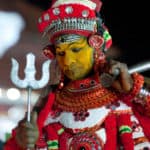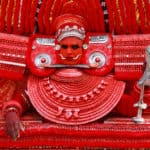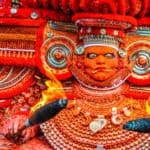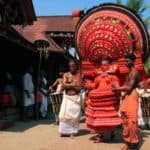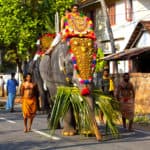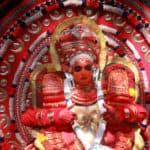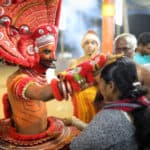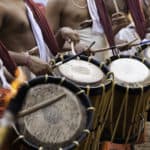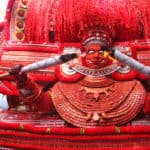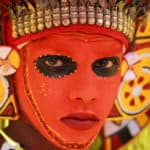Considered to be extremely popular in the North Malabar region in India is a ritualistic dance form known as Theyyam. This “ritual based” dance style has originated from the state of Kerala, and is extremely popular in the Kasaragod and Kannur districts. This dance is usually performed in front of a Hindu shrine, and the performer usually belongs to a low caste. In addition, it is usually performed as a part of “ancestor-worship”, and includes elaborate rites and rituals. Furthermore, this style of dancing possesses a lot of variations some of them included are Pallivettakkorumakan, Vishnumoorthy, and Shree Muthappan Theyyam.
a. History/origin of the Theyyam:
According to the cultural history of the north Malabar region this dance form is said to have elements belonging to the Neolithic and Chalolithic period. Furthermore, it is said that there were many communities in the Malabar region that did not accept the supremacy shown by the Brahmin community. So it is in opposition to this dominance exerted by the Brahmin society that the Theyyam deities was established, and a dance form created to worship it.
b. Costumes used in Theyyam:
There is a lot of variety in terms of the costumes used in this dance form and they include leaf dress i.e. Tazha Adai, headdress also known as muti arayoda, and other body decorations. In addition, many of the costumes used are basically made up of tender coconut, and hence is also discarded after a single performance. Furthermore, specially prepared masks and crowns are also used in this dance.
c. Music involved in the Theyyam:
The musical instruments involved in this dance form include a chenda i.e. a drum, tuti, kuzhal, and veekni. In addition, to the music produced, a ritual song is sung by the dancers and the musicians.
d. Training availability and technique involved in the Theyyam:
The performer in this dance form basically performs in an open space available within a Hindu shrine. The chief dancer carries a sword in the hand, and then dances around the shrine in circles in complete sync with the music and the folk song being sung. This folk song recited is mainly associated to the main deity of the shrine in which the dance is being performed. As for training centre/schools there are none available throughout the country since, this is an indigenous dance form belonging to the north Malabar area, which is generally passed on from one generation to another within a “lower caste community” in the region.



